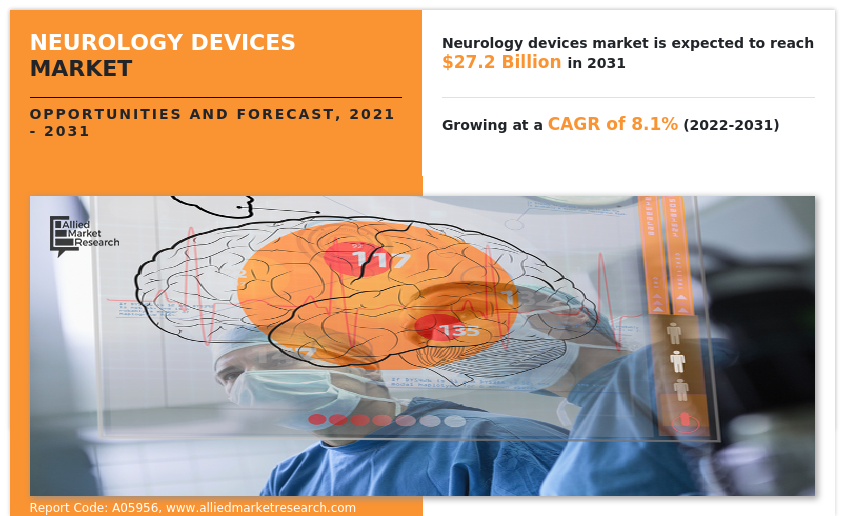
Neurology Devices Market Poised to Surpass $27.2 Billion by 2031, Exhibiting a Robust CAGR of 8.1%

Neurology Devices Industry Size
PORTLAND, OREGON, UNITED STATES, May 29, 2023 /EINPresswire.com/ -- The neurology devices market, an innovative and rapidly evolving sector, demonstrated remarkable growth over the past decade. Starting from a valuation of $12.6 billion in 2021, this dynamic industry is projected to achieve significant milestones, with an estimated value of $27.2 billion by the year 2031. A compound annual growth rate (CAGR) of 8.1% is anticipated between the years 2022 and 2031, signaling robust expansion and promising opportunities within the neurology devices market. This exponential growth trajectory emphasizes the increasing demand for advanced medical technologies and highlights the industry's commitment to enhancing neurological care and improving patient outcomes. As the market continues to evolve, researchers, medical professionals, and manufacturers will collaborate to develop groundbreaking innovations that revolutionize the diagnosis, treatment, and management of neurological conditions, ultimately improving the lives of countless individuals worldwide.
Neurology, a specialized field of medicine, focuses on the study, diagnosis, and treatment of disorders and diseases related to the nervous system. The nervous system is a complex network consisting of cells, tissues, and organs that regulate and coordinate bodily functions. It encompasses vital components such as the brain, spinal cord, and peripheral nerves. Within the realm of neurology, various medical devices have been developed to aid in the diagnosis, treatment, and monitoring of nervous system conditions.
𝐑𝐞𝐪𝐮𝐞𝐬𝐭 𝐑𝐞𝐩𝐨𝐫𝐭 𝐒𝐚𝐦𝐩𝐥𝐞: https://www.alliedmarketresearch.com/request-sample/6321
Key Market Players
𝐌𝐞𝐝𝐭𝐫𝐨𝐧𝐢𝐜 𝐩𝐥𝐜, 𝐁𝐨𝐬𝐭𝐨𝐧 𝐒𝐜𝐢𝐞𝐧𝐭𝐢𝐟𝐢𝐜 𝐂𝐨𝐫𝐩𝐨𝐫𝐚𝐭𝐢𝐨𝐧, 𝐀𝐛𝐛𝐨𝐭𝐭 𝐋𝐚𝐛𝐨𝐫𝐚𝐭𝐨𝐫𝐢𝐞𝐬, 𝐙𝐢𝐦𝐦𝐞𝐫 𝐁𝐢𝐨𝐦𝐞𝐭 𝐇𝐨𝐥𝐝𝐢𝐧𝐠 𝐈𝐧𝐜., 𝐉𝐨𝐡𝐧𝐬𝐨𝐧 & 𝐉𝐨𝐡𝐧𝐬𝐨𝐧, 𝐒𝐭𝐫𝐲𝐤𝐞𝐫 𝐂𝐨𝐫𝐩𝐨𝐫𝐚𝐭𝐢𝐨𝐧, 𝐋𝐢𝐯𝐚𝐍𝐨𝐯𝐚 𝐏𝐋𝐂, 𝐁.𝐁𝐫𝐚𝐮𝐧 𝐒𝐄, 𝐈𝐧𝐭𝐞𝐠𝐫𝐚 𝐋𝐢𝐟𝐞𝐬𝐜𝐢𝐞𝐧𝐜𝐞𝐬, 𝐍𝐚𝐭𝐮𝐬 𝐌𝐞𝐝𝐢𝐜𝐚𝐥 𝐈𝐧𝐜.
1. Neurostimulation Devices: Neurostimulation devices are designed to deliver electrical impulses to specific nerves or areas of the nervous system. They are used to treat various neurological disorders. The device types within this category include:
• Spinal Cord Stimulators: These devices are implanted in the spinal cord to provide pain relief for chronic conditions such as failed back surgery syndrome or complex regional pain syndrome.
• Deep Brain Stimulators: Deep brain stimulators are used to manage symptoms of movement disorders such as Parkinson's disease or essential tremor. They are implanted in specific areas of the brain to regulate abnormal electrical activity.
• Sacral Nerve Stimulators: These devices are employed to treat bladder control problems, bowel control issues, and chronic pelvic pain by modulating the sacral nerves.
• Vagus Nerve Stimulators: Vagus nerve stimulators are used to manage epilepsy and treatment-resistant depression by delivering electrical signals to the vagus nerve, which then influences brain activity.
• Others: This category includes other neurostimulation devices used for various applications such as peripheral nerve stimulation and gastric electrical stimulation.
2. Neurosurgery Devices: Neurosurgery devices are instruments utilized by neurosurgeons during surgical procedures involving the brain, spine, and nervous system. The device types within this category include:
• Neuroendoscopy: Neuroendoscopy involves the use of a thin, flexible tube with a camera and light source (endoscope) to visualize and perform minimally invasive procedures within the brain or spinal cord.
• Neurosurgery Navigations: These devices provide real-time imaging and guidance during neurosurgical procedures, assisting surgeons in precisely locating and targeting areas of interest.
3. Interventional Neurology Devices: Interventional neurology devices are used for minimally invasive procedures to treat vascular disorders of the brain and spinal cord. The device types within this category include:
• Embolization Devices: These devices are utilized to block or reduce blood flow in abnormal blood vessels or aneurysms within the brain or spinal cord.
• Revascularization Devices: Revascularization devices are employed to restore blood flow to blocked or narrowed blood vessels, commonly used in treating conditions such as stroke or cerebral ischemia.
• Thrombectomy Devices: Thrombectomy devices are designed to remove blood clots from arteries and veins, especially in the treatment of acute ischemic stroke.
• Embolic Protection Devices: These devices are used during interventional procedures to capture and remove any dislodged embolic material, preventing it from traveling to other parts of the body.
• Accessory Devices: Accessory devices include various tools and instruments used in interventional neurology procedures, such as microcatheters, guidewires, and stents.
4. Cerebrospinal Fluid (CSF) Management Devices: CSF management devices are utilized in the treatment of conditions that involve the drainage or management of cerebrospinal fluid. The device types within this category include:
• CSF Shunts: CSF shunts are implanted to drain excess cerebrospinal fluid from the brain or spinal cord to another part of the body, such as the abdomen, where it can be absorbed.
• External Drainage System: These devices are used to temporarily drain excess cerebrospinal fluid externally through a catheter, often in critical care settings.
• Others: This category includes other devices and tools used for CSF management, such as reservoirs and valves.
𝐏𝐫𝐨𝐜𝐮𝐫𝐞 𝐂𝐨𝐦𝐩𝐥𝐞𝐭𝐞 𝐑𝐞𝐩𝐨𝐫𝐭 (184 𝐏𝐚𝐠𝐞𝐬 𝐏𝐃𝐅 𝐰𝐢𝐭𝐡 𝐈𝐧𝐬𝐢𝐠𝐡𝐭𝐬, 𝐂𝐡𝐚𝐫𝐭𝐬, 𝐓𝐚𝐛𝐥𝐞𝐬, 𝐚𝐧𝐝 𝐅𝐢𝐠𝐮𝐫𝐞𝐬): https://www.alliedmarketresearch.com/neurology-devices-market/purchase-options
David Correa
Allied Analytics LLP
+ 1-800-792-5285
email us here
Distribution channels: Business & Economy, Healthcare & Pharmaceuticals Industry
Legal Disclaimer:
EIN Presswire provides this news content "as is" without warranty of any kind. We do not accept any responsibility or liability for the accuracy, content, images, videos, licenses, completeness, legality, or reliability of the information contained in this article. If you have any complaints or copyright issues related to this article, kindly contact the author above.
Submit your press release